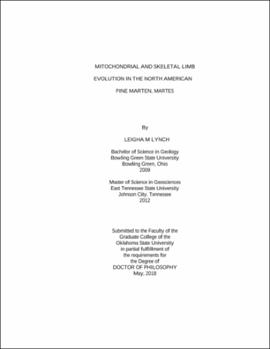| dc.contributor.advisor | Weil, Anne | |
| dc.contributor.author | Lynch, Leigha M. | |
| dc.date.accessioned | 2023-04-26T16:20:23Z | |
| dc.date.available | 2023-04-26T16:20:23Z | |
| dc.date.issued | 2018-05 | |
| dc.identifier.uri | https://hdl.handle.net/11244/337468 | |
| dc.description.abstract | The vertebrate fossil record is comprised almost entirely of skeletal and dental elements. Skeletal morphology can be influenced by genetic evolution, climate, biome, and behavior. Because of this, paleontologists often use the skeleton to construct phylogenetic relationships, interpret past biomes and climate, and infer behavior. The interaction of genetics, climate, biome, and behavior can be complex and difficult to construct from extinct taxa alone. Many paleontologists, therefore, use extant species as a framework for determining how skeletal morphology evolves in response to these variables. Because many living species are represented in the Pleistocene fossil record, it is also possible to quantifying their morphological evolution through time. This dissertation seeks to understand how skeletal limb morphology evolves in response to climate and biome using North American pine martens, Martes, species commonly included in phylogenetic and ecomorphological studies, as a model. | |
| dc.description.abstract | Using linear measurements and morphometric shape data, I found that the skeletal morphology of M. americana and M. caurina differs among biomes and in correlation with climate. By time calibrating a Bayesian phylogeny constructed from mitochondrial genes from these same specimens, I found that M. americana and M. caurina likely underwent genetic divergence during the Late Pleistocene while isolated in different habitats by glaciers. This suggests that the morphology of these species evolved as an adaptation to climate and biome. Through phylogenetic comparative methods, I found limb shape did not evolve as an adaptation, but instead likely arose in conjunction with genetic drift in these isolated Pleistocene populations. A similar mode of evolution has occurred in recent history, resulting in M. americana having undergone no appendicular morphological evolution despite recent climate change. | |
| dc.description.abstract | These results suggest that the survival of North American Martes through past and current climate change may be because they are ecological generalists. Generalists have the advantage when faced with changes in climate and biome that they can shift their geographic range or alternate food sources. This supports the notion that the ecology of a species can influence its phenotypic evolution and should be considered when using extant species to infer the evolutionary history of extinct taxa. | |
| dc.format | application/pdf | |
| dc.language | en_US | |
| dc.rights | Copyright is held by the author who has granted the Oklahoma State University Library the non-exclusive right to share this material in its institutional repository. Contact Digital Library Services at lib-dls@okstate.edu or 405-744-9161 for the permission policy on the use, reproduction or distribution of this material. | |
| dc.title | Mitochondrial and skeletal limb evolution in the North American pine marten, Martes | |
| dc.contributor.committeeMember | O'Brien, Haley D | |
| dc.contributor.committeeMember | Wilson, Nedra | |
| dc.contributor.committeeMember | Booth, Warren | |
| dc.contributor.committeeMember | Quan, Tracy | |
| osu.filename | Lynch_okstate_0664D_15721.pdf | |
| osu.accesstype | Open Access | |
| dc.type.genre | Dissertation | |
| dc.type.material | Text | |
| dc.subject.keywords | adaptation | |
| dc.subject.keywords | appendicular | |
| dc.subject.keywords | climate | |
| dc.subject.keywords | Martes | |
| dc.subject.keywords | morphology | |
| dc.subject.keywords | phylogenetic | |
| thesis.degree.discipline | Biomedical Sciences | |
| thesis.degree.grantor | Oklahoma State University | |
